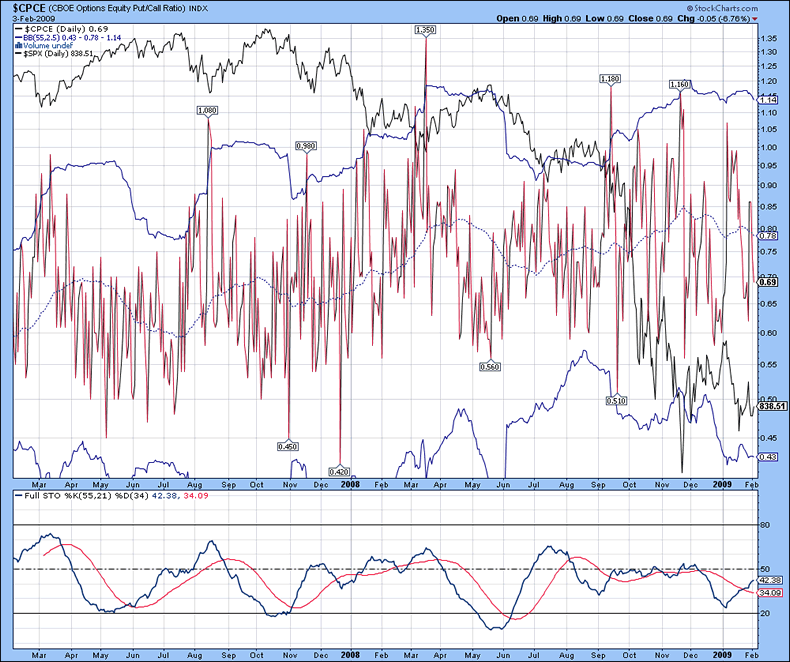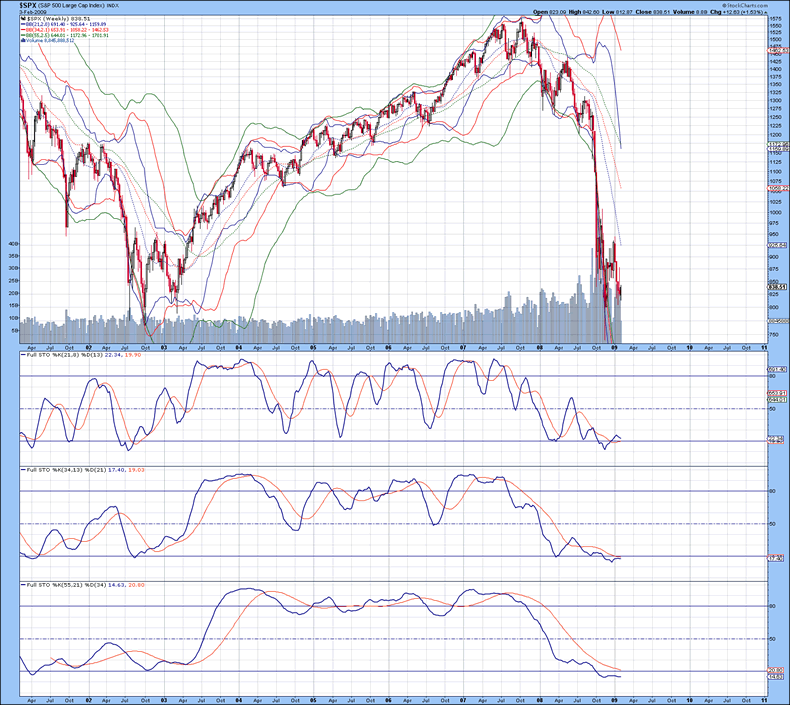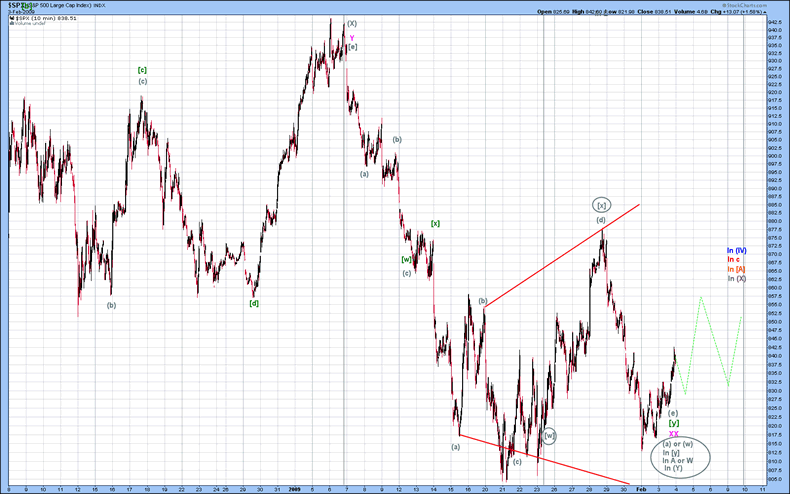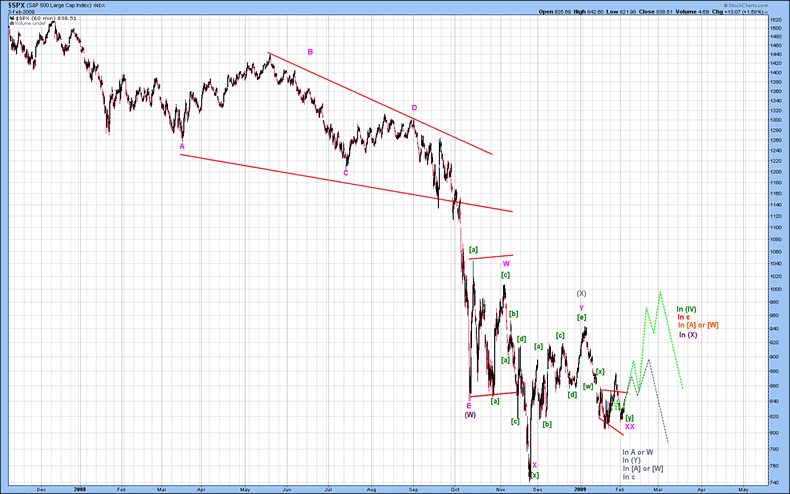Stocks Bear Market Will Run into 2012 Targeting S&P 500
Stock-Markets / Stocks Bear Market Feb 05, 2009 - 06:29 AM GMTBy: David_Petch
 The S&P had an impressive move up off the lows yesterday…however, as the Elliott Wave counts will suggest, market action subsequent to the bounce over the coming few days is important for validating either the bullish or bearish scenario.
The S&P had an impressive move up off the lows yesterday…however, as the Elliott Wave counts will suggest, market action subsequent to the bounce over the coming few days is important for validating either the bullish or bearish scenario.
The CBOE Options Equity Put/Call Ratio Index is shown below, with the S&P 500 Index in the background and accompanying full stochastics shown below. For this chart, the %K rising above the %D indicates broad stock market weakness, while falling beneath the %D indicates broad stock market strength. At present, the %K is above the %D, indicating broad market weakness.
Figure 1

The daily chart of the S&P 500 Index is shown below with the upper 21 and 34 MA Bollinger bands in close proximity an the lower 21 MA BB beneath the 34 MA BB. Having the lower 21 MA BB beneath the lower 34 MA BB generally is a sign of a short-term oversold condition, but given current market weakness, a sharp move down would negate this and signal extreme weakness. Full stochastics 1, 2 and 3 are shown below in order of descent, with stochastics 1 and 3 having the %K above the %D. With stochastic 2 having the %K beneath the %D, as per Bollinger band analysis, a mid-term stochastic setting out of phase with the shorter and longer term generally indicates a short-term oversold condition. Anyone going long, play with cards close to your chest…any sign of a market decline beneath 805 is an indication to go to cash.
Figure 2

The weekly chart of the S&P 500 Index is shown below, with lower 34 and 55 week MA Bollinger bands still declining beneath last weeks values (654 and 644 versus 666 and 665, respectively). Upper Bollinger bands are still declining, indicating the sharp decline from the back half of 2008 is far from over. Full stochastics 1, 2 and 3 are shown below in order of descent, with the %K marginally above the %D in stochastic #1. All three stochastics are at extremely oversold conditions and could become more oversold. In order for stochastic 1 to curl up and indicate the potential for a 1-2 month rally, all of the ducks on the daily chart must line up first.
Figure 3

The monthly chart of the S&P 500 Index is shown below, with all lower Bollinger bands riding beneath the index, supportive of the S&P 500 Index declining for most of 2009. Note that the S&P fell below the 50, 155 and 200 month moving averages since 1990….this does not portend well for most of 2009. Full stochastics 1, 2 and 3 are shown below in order of descent, with the %K beneath the %D in all three instances. Based upon this chart, a firm market bottom is not likely due for 12-18 months from now.
Figure 4

The short-term Elliott Wave count of the S&P 500 Index is shown below, with the preferred count shown in colour and the alternate count shown in grey. Based upon the preferred count, wave XX completed an expanding triangle which suggests that wave Z should be a very grinding pattern over the course of the next 4-6 weeks, with a price range between 810 and 875. If the S&P rises to 860-870 over the course of the next 3-5 days, it is possible that wave (b) of a flat may be forming. If the 805 level EVER becomes pierced over the next 5-10 trading days, it would indicate the recent decline was wave part of wave (Y), which would have a severe decline sequence lasting until the S&P bottoms around 450-550. For the preferred count to remain valid, the S&P should follow the green lines or a similar sort of pattern and simply grind sideways into mid February before rising.
Figure 5

The mid-term chart of the S&P 500 Index is shown below with the preferred count shown in colour and the alternate count shown in grey. If the S&P can go sideways over the course of the next 5-10 trading days, then it is possible the path denoted in green occurs. Should the alternate count occur, a pattern similar to the one shown below could develop or it simply could cascade lower. The important level is 805…a breach of this level would negate any bullish price action and immediately cast a dark shadow upon the broad market indices.
Figure 6

The long-term Elliott Wave chart of the S&P 500 Index is shown below with the preferred count shown in colour and the alternate count shown in grey. Since wave c down is likely to go to 450-550, it is highly probable that wave IV is going to form a neutral triangle i.e. wave c is the longest wave in the triangle, followed by wave d taking ½ to ¾ the time and a wave e down to end the pattern. A final end to the pattern is not due until 2012/2013.
Figure 7

That is all for today…I will update the US Dollar Index tomorrow AM. Have a great day.
By David Petch
http://www.treasurechests.info
I generally try to write at least one editorial per week, although typically not as long as this one. At www.treasurechests.info , once per week (with updates if required), I track the Amex Gold BUGS Index, AMEX Oil Index, US Dollar Index, 10 Year US Treasury Index and the S&P 500 Index using various forms of technical analysis, including Elliott Wave. Captain Hook the site proprietor writes 2-3 articles per week on the “big picture” by tying in recent market action with numerous index ratios, money supply, COT positions etc. We also cover some 60 plus stocks in the precious metals, energy and base metals categories (with a focus on stocks around our provinces).
With the above being just one example of how we go about identifying value for investors, if this is the kind of analysis you are looking for we invite you to visit our site and discover more about how our service can further aid in achieving your financial goals. In this regard, whether it's top down macro-analysis designed to assist in opinion shaping and investment policy, or analysis on specific opportunities in the precious metals and energy sectors believed to possess exceptional value, like mindedly at Treasure Chests we in turn strive to provide the best value possible. So again, pay us a visit and discover why a small investment on your part could pay you handsome rewards in the not too distant future.
And of course if you have any questions, comments, or criticisms regarding the above, please feel free to drop us a line . We very much enjoy hearing from you on these items.
Disclaimer: The above is a matter of opinion and is not intended as investment advice. Information and analysis above are derived from sources and utilizing methods believed reliable, but we cannot accept responsibility for any trading losses you may incur as a result of this analysis. Comments within the text should not be construed as specific recommendations to buy or sell securities. Individuals should consult with their broker and personal financial advisors before engaging in any trading activities as we are not registered brokers or advisors. Certain statements included herein may constitute "forward-looking statements" with the meaning of certain securities legislative measures. Such forward-looking statements involve known and unknown risks, uncertainties and other factors that may cause the actual results, performance or achievements of the above mentioned companies, and / or industry results, to be materially different from any future results, performance or achievements expressed or implied by such forward-looking statements. Do your own due diligence.
Copyright © 2009 treasurechests.info Inc. All rights reserved.
Unless otherwise indicated, all materials on these pages are copyrighted by treasurechests.info Inc. No part of these pages, either text or image may be used for any purpose other than personal use. Therefore, reproduction, modification, storage in a retrieval system or retransmission, in any form or by any means, electronic, mechanical or otherwise, for reasons other than personal use, is strictly prohibited without prior written permission.
David Petch Archive |
© 2005-2022 http://www.MarketOracle.co.uk - The Market Oracle is a FREE Daily Financial Markets Analysis & Forecasting online publication.



